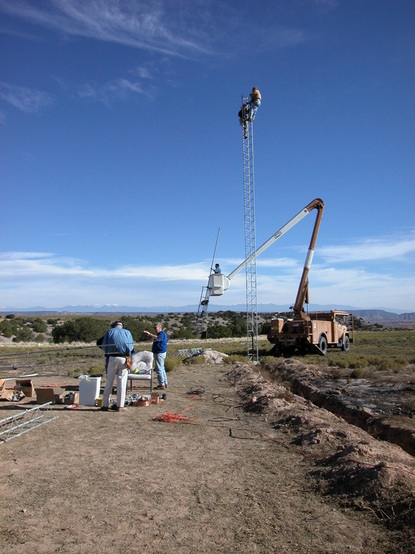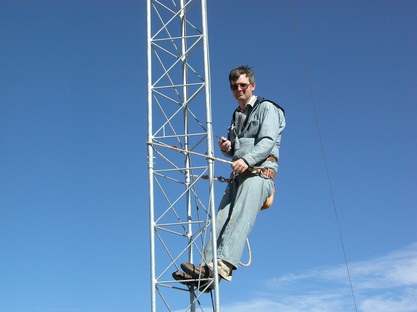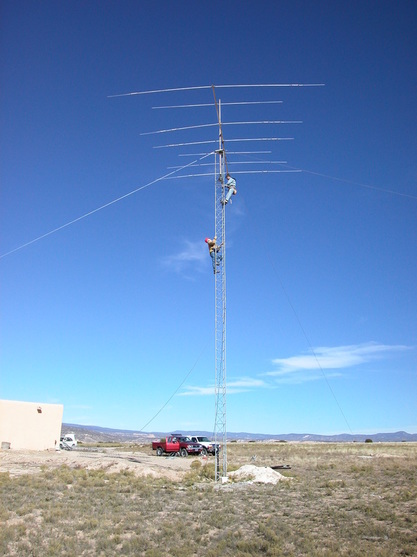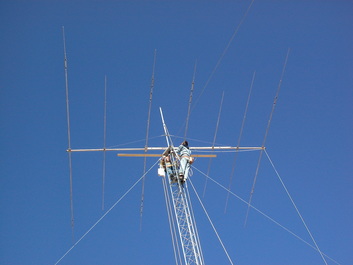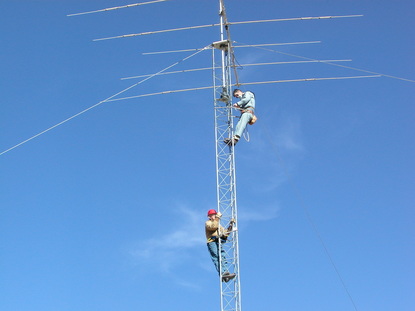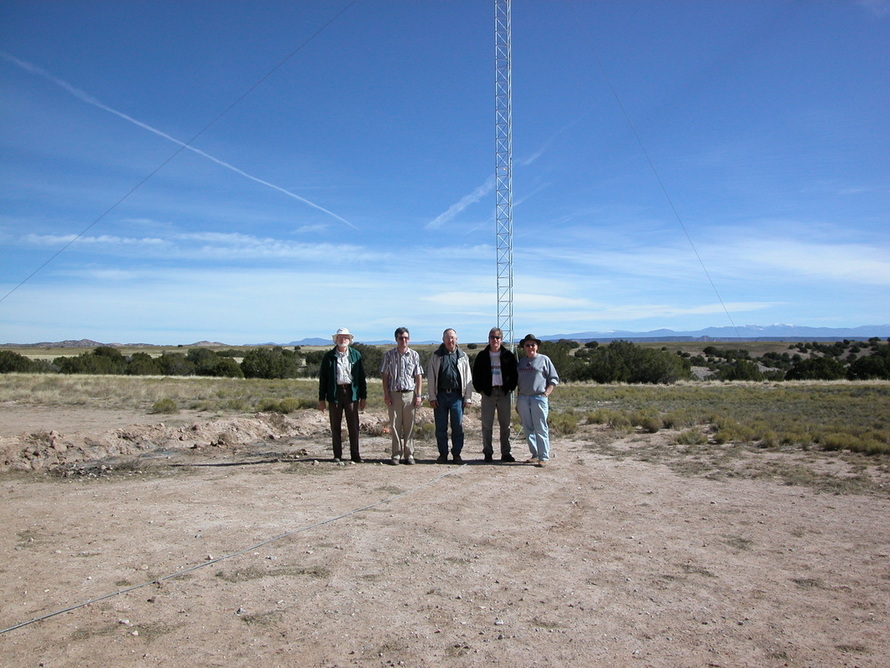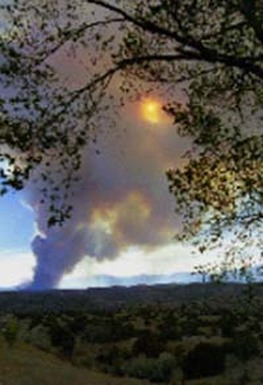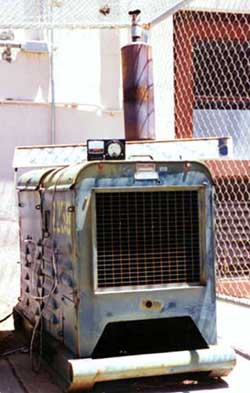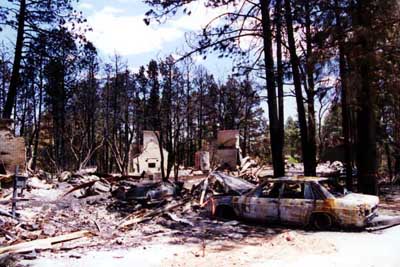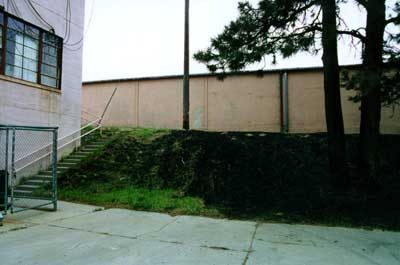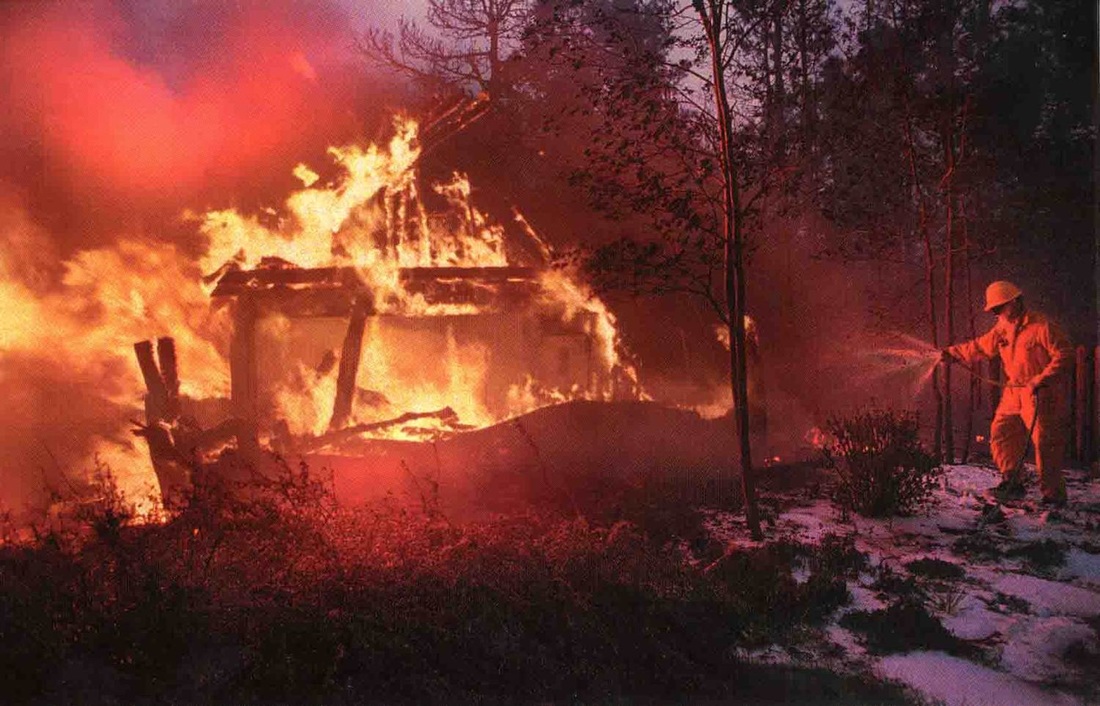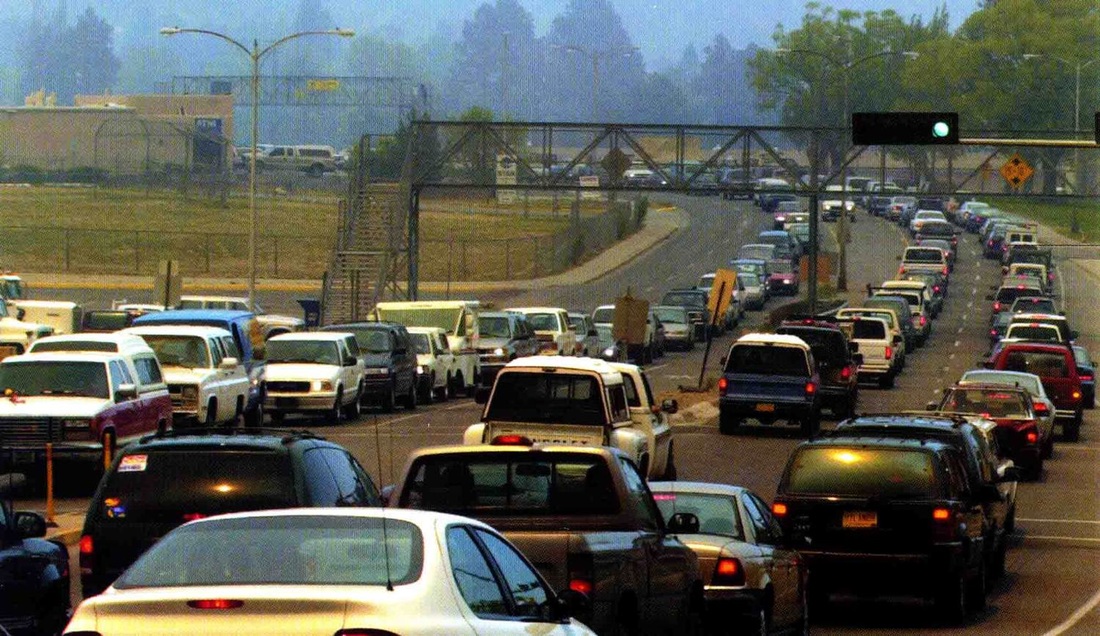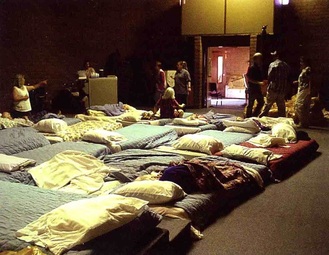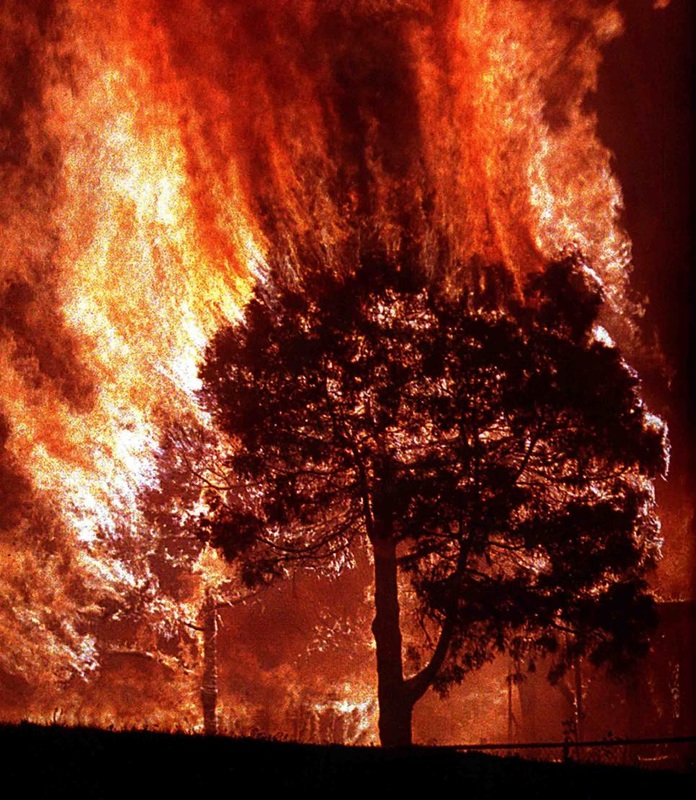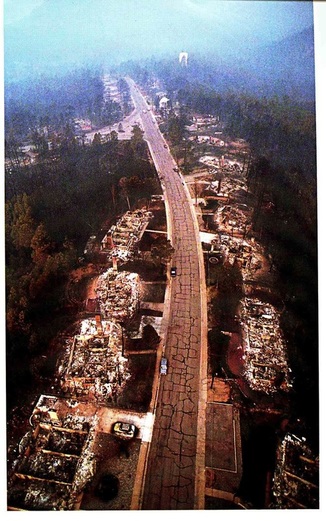Table of Contents
2005
Antenna Rising at NI5G
Photos by Richard Browning, AD5RB
Antenna Rising at NI5G
Photos by Richard Browning, AD5RB
|
Ready to go: getting started with raising the tower itself using the lift truck.
From left to right: Ted Karki (W5VXE), Mike Smith (K0CCM), and Louis Wise "Bing" (NI5G) together with the lift truck operator.
Tom Beery (WD5CAW) working on the tower.
|
Ted Karki (W5VXE, bottom) and Tom Beery (WD5CAW, top) working on the tower.
Ted Karki (W5VXE) and Tom Beery (WD5CAW) working on the nearly completed antenna on top of the tower.
Ted Karki (W5VXE, bottom) and Tom Beery (WD5CAW, top) descending the tower.
|
All done! From left to right: Richard Browning (AD5RB), Tom Beery (WD5CAW), Ted Karki (W5VXE), the lift truck operator, and Louis Wise "Bing" (NI5G).
April 11, 2001
New Repeater at W5PDO - The End of an Era
Alden Oyer, AG5S
New Repeater at W5PDO - The End of an Era
Alden Oyer, AG5S
What might be the longest-running repeater chassis in the world was retired on Wednesday when the 146.88 vacuum tube repeater was replaced with a new solid state version. The original repeater was placed in service at its present location in the base of the "white golfball on at Tee" water tower on Barranca Mesa on October 18, 1968. It has remained on the air continuously since then except for short intervals when power service was interrupted or the machine was down for repair. The transmitter and receiver were a Motorola Mobile 80D, modified for fixed service by replacing the dynamotors with a power supply fed from the commercial mains. The RTL controller was home brewed by the club. The Morse ID was generated electro-optically by shining a light onto a photocell through a rotating, perforated disk. Although many tubes were replaced over the years, the Morse ID light is the original bulb, having never burned out.
In the past year or so, age was beginning to take its toll. In addition to occasional tube replacements, passive components including resistors, capacitors and transformers were failing with increasing frequency. Bob Cowan, K5QIN, acquired and assembled the components for the new solid-state repeater - a transmitter strip from a Motorola Motran, a receiver strip from a GE MASTR, and an NHRC-2 controller. Bob has programmed a short squelch tail and no courtesy beep, and has added an audio delay circuit to eliminate squelch pop. The repeater uses the same home-built duplexer of the old repeater, a 4-cavity hybrid ring. Some work still need to be performed to lessen the 6 db loss through the duplexer, and the antenna, several hundred feet up on top of the water tower, needs to be checked. Any volunteers for the latter task (or should I say ladder task)?
The simplex autopatch, previously on 147.99 MHz, has QSYed to the repeater. To access this open autopatch, identify yourself, send *88, and release the PTT. Wait for the dialtone to disappear and then enter your number. Remember, this is a simplex autopatch. Only one person talks at a time. When you are finished, press # to hang up. A rapid Morse ID will indicate success.
Please use the repeater and let us know its coverage and how it performs. You can e-mail comments directly to AG5S.
In the past year or so, age was beginning to take its toll. In addition to occasional tube replacements, passive components including resistors, capacitors and transformers were failing with increasing frequency. Bob Cowan, K5QIN, acquired and assembled the components for the new solid-state repeater - a transmitter strip from a Motorola Motran, a receiver strip from a GE MASTR, and an NHRC-2 controller. Bob has programmed a short squelch tail and no courtesy beep, and has added an audio delay circuit to eliminate squelch pop. The repeater uses the same home-built duplexer of the old repeater, a 4-cavity hybrid ring. Some work still need to be performed to lessen the 6 db loss through the duplexer, and the antenna, several hundred feet up on top of the water tower, needs to be checked. Any volunteers for the latter task (or should I say ladder task)?
The simplex autopatch, previously on 147.99 MHz, has QSYed to the repeater. To access this open autopatch, identify yourself, send *88, and release the PTT. Wait for the dialtone to disappear and then enter your number. Remember, this is a simplex autopatch. Only one person talks at a time. When you are finished, press # to hang up. A rapid Morse ID will indicate success.
Please use the repeater and let us know its coverage and how it performs. You can e-mail comments directly to AG5S.
May 2000
Cerro Grande Fire
Cerro Grande Fire
Here is one club member's chronicle of the amateur radio support for the Cerro Grande Fire in May, 2000. Bob Cowan, K5QIN (SK), submitted this article to QST where it was edited and published as the lead of the Public Service column in the February 2001 QST (pp 96-97).
Wildfire!
Bob Cowan, K5QIN (SK)
Bob Cowan, K5QIN (SK)
Over a hundred hams responded to provide communications during a large forest fire near Los Alamos, New Mexico in early May 2000. It was by far the largest emergency ever supported by amateurs in this area.
The Cerro Grande Fire began on May 4, 2000 in Bandelier National Monument, New Mexico, in an attempt to reduce the fuel content of 1000 acres of forest by igniting a "controlled burn." High winds and extremely dry conditions caused the to fire quickly escape its intended boundaries. Before it was extinguished several weeks later it had consumed 48,000 acres of forest, destroyed 261 residences in Los Alamos, and left 444 families homeless. Firefighting costs exceeded $15 million and the total cost was expected to approach $1 billion.
The Los Alamos Amateur Radio Club, since its founding in 1948, has been involved in many emergency communications operations. In the 1950s, Los Alamos was considered a prime target for a nuclear attack. Plans were made to evacuate the town to communities in southern Colorado. We participated in evacuation drills and set up HF radio communications among several locations. After international tensions eased we joined several other volunteer groups to form a search and rescue organization. This continues to be our primary public service activity. We are not strangers to forest fires. When the La Mesa fire threatened Los Alamos in 1977 we were very active in assisting the U.S. Forest Service with communications [1]. Over the years we have developed a very well equipped club station, W5PDO. We have excellent HF facilities as well as numerous VHF and UHF radios. Four telephone lines, a FAX machine, and several computers add to our capability. An emergency electrical generator can power the station. Field Day has always been our favorite club activity. This experience was very useful during the Cerro Grande Fire.
We were first activated on Sunday evening, May 7. W5PDO was opened and we were to be in service for two weeks, including many days and nights of continuous operation. Our first duties were to staff three Red Cross shelters and the Los Alamos County Emergency Operations Center (EOC.) About 500 residences in Los Alamos were evacuated that evening. Many persons occupied shelters in nearby White Rock; others went to locations in the Rio Grande valley. Hundreds of messages were passed among the shelters regarding supplies, staffing, and location of shelter residents. Operations continued this way on Monday, May 8.
The Cerro Grande Fire began on May 4, 2000 in Bandelier National Monument, New Mexico, in an attempt to reduce the fuel content of 1000 acres of forest by igniting a "controlled burn." High winds and extremely dry conditions caused the to fire quickly escape its intended boundaries. Before it was extinguished several weeks later it had consumed 48,000 acres of forest, destroyed 261 residences in Los Alamos, and left 444 families homeless. Firefighting costs exceeded $15 million and the total cost was expected to approach $1 billion.
The Los Alamos Amateur Radio Club, since its founding in 1948, has been involved in many emergency communications operations. In the 1950s, Los Alamos was considered a prime target for a nuclear attack. Plans were made to evacuate the town to communities in southern Colorado. We participated in evacuation drills and set up HF radio communications among several locations. After international tensions eased we joined several other volunteer groups to form a search and rescue organization. This continues to be our primary public service activity. We are not strangers to forest fires. When the La Mesa fire threatened Los Alamos in 1977 we were very active in assisting the U.S. Forest Service with communications [1]. Over the years we have developed a very well equipped club station, W5PDO. We have excellent HF facilities as well as numerous VHF and UHF radios. Four telephone lines, a FAX machine, and several computers add to our capability. An emergency electrical generator can power the station. Field Day has always been our favorite club activity. This experience was very useful during the Cerro Grande Fire.
We were first activated on Sunday evening, May 7. W5PDO was opened and we were to be in service for two weeks, including many days and nights of continuous operation. Our first duties were to staff three Red Cross shelters and the Los Alamos County Emergency Operations Center (EOC.) About 500 residences in Los Alamos were evacuated that evening. Many persons occupied shelters in nearby White Rock; others went to locations in the Rio Grande valley. Hundreds of messages were passed among the shelters regarding supplies, staffing, and location of shelter residents. Operations continued this way on Monday, May 8.
Left: The Cerro Grande Fire as it approached Los Alamos on Sunday, May 7. Five hundred residences were evacuated that evening. Right: In the mid-1960s the Los Alamos Amateur Radio Club obtained a surplus electrical generator. It was a military unit, PU/58G, probably dating to WWII. We wired it to our club station with a transfer switch. Over the years it was rarely used and received sporadic maintenance. With the advent of the dreaded Y2K event we completely refurbished it. That event passed without incident. However, in March of 2000, New Mexico suffered a massive power outage. We fired up the generator and had our station ready to assist with any contingency. After about 20 minutes of operation the generator suddenly speeded up because of a broken pulley on its governor. The line voltage probably exceeded 200 volts and we lost several pieces of equipment. Undaunted, we replaced the broken pulley and repaired the damaged equipment. We were ready for another emergency. Little did we know . . . .
On Tuesday, May 9, the winds calmed and Forest Service firefighters felt that they had a good chance to control the fire. Bulldozers built fire lines, backfires were lighted, and slurry bombers dropped huge loads of red fire retardant. Everyone hoped for the best. But high, gusty winds were forecast for the next day. Communications activities continued as they had on Monday with large numbers of messages being passed among many stations.
The wind returned on Wednesday, May 10 with a vengeance. At 8:30 AM County officials expressed concern that the fire lines would not hold. We were notified of an impending evacuation of the entire community at about 10 AM. Club members packed a few prized personal possessions and assembled at W5PDO to assist with the evacuation. The Los Alamos Police Department asked us to man about a dozen locations along three evacuation routes. With gusty, 60 mph winds the fire line was soon breached. The first evacuation order by an automated telephone notification system came at 2 PM; the second and final one an hour later. About 10,000 people were evacuated yet it proceeded quite orderly.
Several club members stayed at W5PDO during the early stages of the evacuation. We intended to "tough if out" if at all possible. At about 4 PM, though, flames topped a ridgeline only a half-mile from our club station and headed our way. We decided then that valor had its limits. We grabbed several VHF radios, a computer, our logs, and joined the evacuation. Police and National Guardsmen were stationed along the way to ensure a smooth flow of traffic. The air was thick with smoke and homes were burning only a few blocks away as we made our way out of town.
We moved our operations to White Rock, about 10 miles away, where we commandeered a room in the Senior Center. Two VHF radios and antennas were quickly set up. Operations continued there for several hours. At about 1:30 AM, though, the fire was reported to be heading for White Rock. An immediate evacuation of that community was ordered. This proved to be a nightmare as the normal population of 7000 had grown substantially by the previous evacuations. Only one road led out of town. We closed operations, rounded up our families, and headed for safer locations. At this time, radio communications control was assumed by the State EOC in Santa Fe, which was manned by members of Santa Fe County RACES and using the callsign of the Santa Fe Amateur Radio Club, W5SF.
On Thursday, May 11 we followed news reports hoping to hear that the fire had spared our homes. Most of us were so blessed. Many of our friends and several hams were not so lucky. New Red Cross shelters were set up in Pojoaque, Santa Fe, and Glorieta. Hams were stationed there and a huge volume of traffic was passed. The efforts of firefighters had saved a large part of Los Alamos from total destruction but the fire continued to burn out of control toward the north. The State EOC sent a mobile command post that was staffed by hams from Albuquerque. They monitored the fire's progress as it headed toward Santa Clara Pueblo tribal land.
One of our club members talked his was through roadblocks and returned to Los Alamos on Friday, May 12. He found that the club station had survived the fire, but barely. Grass had burned to the edge of the building. Several large Ponderosa pine trees a few tens of feet away had their lower limbs burned. Their tops had not caught fire, however. Had this happened, the windows of the clubroom would have broken and everything inside would have been destroyed. Only 300 feet from the front of building were the smoldering ruins of three multi-family residences. We were lucky; very, very lucky.
Electrical power was out in that part of town because of burned power poles. But our generator started without hesitation. It saw continuous use for a week. Club members were called back and we resumed operations at about 4 PM. Upon returning to town it appeared to us that Los Alamos was in a war zone. Firefighters and police from all over New Mexico had come to help. National Guardsmen in humvees were everywhere. Huge fleets of school busses were assembled to carry firefighters to their difficult tasks. A dozen helicopters were overhead, some carrying thousand-gallon loads of water to fight the fire, others ferrying Hot Shot crews to battle the blaze. Firemen constantly patrolled the streets extinguishing spot fires.
The wind returned on Wednesday, May 10 with a vengeance. At 8:30 AM County officials expressed concern that the fire lines would not hold. We were notified of an impending evacuation of the entire community at about 10 AM. Club members packed a few prized personal possessions and assembled at W5PDO to assist with the evacuation. The Los Alamos Police Department asked us to man about a dozen locations along three evacuation routes. With gusty, 60 mph winds the fire line was soon breached. The first evacuation order by an automated telephone notification system came at 2 PM; the second and final one an hour later. About 10,000 people were evacuated yet it proceeded quite orderly.
Several club members stayed at W5PDO during the early stages of the evacuation. We intended to "tough if out" if at all possible. At about 4 PM, though, flames topped a ridgeline only a half-mile from our club station and headed our way. We decided then that valor had its limits. We grabbed several VHF radios, a computer, our logs, and joined the evacuation. Police and National Guardsmen were stationed along the way to ensure a smooth flow of traffic. The air was thick with smoke and homes were burning only a few blocks away as we made our way out of town.
We moved our operations to White Rock, about 10 miles away, where we commandeered a room in the Senior Center. Two VHF radios and antennas were quickly set up. Operations continued there for several hours. At about 1:30 AM, though, the fire was reported to be heading for White Rock. An immediate evacuation of that community was ordered. This proved to be a nightmare as the normal population of 7000 had grown substantially by the previous evacuations. Only one road led out of town. We closed operations, rounded up our families, and headed for safer locations. At this time, radio communications control was assumed by the State EOC in Santa Fe, which was manned by members of Santa Fe County RACES and using the callsign of the Santa Fe Amateur Radio Club, W5SF.
On Thursday, May 11 we followed news reports hoping to hear that the fire had spared our homes. Most of us were so blessed. Many of our friends and several hams were not so lucky. New Red Cross shelters were set up in Pojoaque, Santa Fe, and Glorieta. Hams were stationed there and a huge volume of traffic was passed. The efforts of firefighters had saved a large part of Los Alamos from total destruction but the fire continued to burn out of control toward the north. The State EOC sent a mobile command post that was staffed by hams from Albuquerque. They monitored the fire's progress as it headed toward Santa Clara Pueblo tribal land.
One of our club members talked his was through roadblocks and returned to Los Alamos on Friday, May 12. He found that the club station had survived the fire, but barely. Grass had burned to the edge of the building. Several large Ponderosa pine trees a few tens of feet away had their lower limbs burned. Their tops had not caught fire, however. Had this happened, the windows of the clubroom would have broken and everything inside would have been destroyed. Only 300 feet from the front of building were the smoldering ruins of three multi-family residences. We were lucky; very, very lucky.
Electrical power was out in that part of town because of burned power poles. But our generator started without hesitation. It saw continuous use for a week. Club members were called back and we resumed operations at about 4 PM. Upon returning to town it appeared to us that Los Alamos was in a war zone. Firefighters and police from all over New Mexico had come to help. National Guardsmen in humvees were everywhere. Huge fleets of school busses were assembled to carry firefighters to their difficult tasks. A dozen helicopters were overhead, some carrying thousand-gallon loads of water to fight the fire, others ferrying Hot Shot crews to battle the blaze. Firemen constantly patrolled the streets extinguishing spot fires.
Rod Whitaker, KA5MYE, operates the VHF position at W5PDO during the Cerro Grande fire. Last year's "Field Day Log" sits on the raceway above him.
We set up a computer spreadsheet program to schedule operations at W5PDO, Red Cross shelters in the Pojoaque Valley, Santa Fe, and Glorieta. Our assistance was again needed at the County EOC. Los Alamos was still under an evacuation order, yet many workers were needed in town to assist with firefighting, security, and recovery operations. A police roadblock was established to clear these persons into town. The roadblock was located in Totavi, a location notorious for its poor radio coverage into Los Alamos. We set up a crossband simplex repeater on Tsankawi Mesa that gave good coverage to this location. Hams were stationed at the roadblock. The names of incoming persons were relayed to the EOC where approval was given for them to enter town. This link removed an immense amount of traffic from the already overcrowded channels.
About 90 percent of our communications was carried out on the 145.19 MHz KB5RX repeater located on Pajarito Mountain, just west of Los Alamos. This repeater is solar powered and performed magnificently during the entire operation. Much to our relief, its batteries held up under heavy nighttime operation. Other electronic sites on Pajarito Mountain were served by commercial power. They failed when the power lines on the mountain were destroyed by fire. Ham ingenuity and forethought was the key to this successful operation. Other repeaters were also used including W5PDO in Los Alamos, W5SF on Tesuque Peak near Santa Fe, and the KB5ZQE UHF link to W5SF on Elk Mountain. Numerous simplex frequencies were used as occasions demanded.
The fire had moved beyond Los Alamos by Saturday, May 13 and recovery operations began immediately. Utilities needed to be restored before residents could be allowed to return to town. A public information center was set up with 50 telephone lines. It was manned by volunteers who answered many questions from evacuees. Two hams were stationed there. Many pets were left behind when the town was evacuated. Several out-of-town animal rescue agencies arrived to assist with locating, evacuating, and feeding many animals. We provided hams to accompany these persons, as they were not familiar with the town. Over 500 pets were assisted by this operation.
We provided "followers" to assist County officials as they traveled around town. Using 2-meter hand-held radios, they were always in instant contact with the EOC, Red Cross, and other agencies. New Mexico citizens donated an enormous amount of relief supplies. Getting it to Los Alamos was a problem. Several hams volunteered their trucks to help with this operation. Communications assignments often changed hourly but there was always someone ready to take on any job that came up. We never lacked for people to assist at any location. The cooperation of all hams in New Mexico was superb.
Residents of White Rock were allowed to return home on Sunday evening, May 15. Most of those living in Los Alamos followed the next day. Our communications requirements slowed considerably as Red Cross Shelters were closed and roadblocks were no longer needed. For the first time in several days we operated only 12 hours a day instead of 24. Operations gradually wound down through Friday and were suspended for the weekend. Commercial power was restored to the part of town where W5PDO is located on Friday. We threw the transfer switch and unceremoniously pushed the "OFF" button on the generator, thanking our lucky stars that it had performed so well. We operated briefly the following Monday and then closed down completely.
About 90 percent of our communications was carried out on the 145.19 MHz KB5RX repeater located on Pajarito Mountain, just west of Los Alamos. This repeater is solar powered and performed magnificently during the entire operation. Much to our relief, its batteries held up under heavy nighttime operation. Other electronic sites on Pajarito Mountain were served by commercial power. They failed when the power lines on the mountain were destroyed by fire. Ham ingenuity and forethought was the key to this successful operation. Other repeaters were also used including W5PDO in Los Alamos, W5SF on Tesuque Peak near Santa Fe, and the KB5ZQE UHF link to W5SF on Elk Mountain. Numerous simplex frequencies were used as occasions demanded.
The fire had moved beyond Los Alamos by Saturday, May 13 and recovery operations began immediately. Utilities needed to be restored before residents could be allowed to return to town. A public information center was set up with 50 telephone lines. It was manned by volunteers who answered many questions from evacuees. Two hams were stationed there. Many pets were left behind when the town was evacuated. Several out-of-town animal rescue agencies arrived to assist with locating, evacuating, and feeding many animals. We provided hams to accompany these persons, as they were not familiar with the town. Over 500 pets were assisted by this operation.
We provided "followers" to assist County officials as they traveled around town. Using 2-meter hand-held radios, they were always in instant contact with the EOC, Red Cross, and other agencies. New Mexico citizens donated an enormous amount of relief supplies. Getting it to Los Alamos was a problem. Several hams volunteered their trucks to help with this operation. Communications assignments often changed hourly but there was always someone ready to take on any job that came up. We never lacked for people to assist at any location. The cooperation of all hams in New Mexico was superb.
Residents of White Rock were allowed to return home on Sunday evening, May 15. Most of those living in Los Alamos followed the next day. Our communications requirements slowed considerably as Red Cross Shelters were closed and roadblocks were no longer needed. For the first time in several days we operated only 12 hours a day instead of 24. Operations gradually wound down through Friday and were suspended for the weekend. Commercial power was restored to the part of town where W5PDO is located on Friday. We threw the transfer switch and unceremoniously pushed the "OFF" button on the generator, thanking our lucky stars that it had performed so well. We operated briefly the following Monday and then closed down completely.
Left: One of many fire-ravaged neighborhoods in Los Alamos after the Cerro Grande fire. Right: Grass burned to the edge of our club station building. The power pole in the center of the picture nearly burned through at its base.
Our logs showed that 134 individual hams and two club stations participated in this operation. They gave 2500 hours of service over a period of 14 days. Fifteen different locations, including eight Red Cross shelters, were served. Messages, largely unrecorded, probably numbered in the thousands.
It has been said, "Wisdom is examined experience." Here are a few things we learned that might be useful to others who are involved in a similar emergency.
The most difficult time at W5PDO was at night when the winds calmed and smoke moved into every nook and cranny. With every breath we smelled smoke. After catching a few catnaps in the wee hours of Monday morning, May 15, we awoke to hear a robin singing. At that point we knew that all would be well again. New trees would grow and be green again. Los Alamos would be restored to its natural beauty, but not in our lifetimes, nor in that of our grandchildren. Fire, though far more terrifying and destructive, is as much a part of nature as gentle rain and spring flowers.
It has been said, "Wisdom is examined experience." Here are a few things we learned that might be useful to others who are involved in a similar emergency.
- Ask for help. Many hams with will respond with abounding enthusiasm to perform any task that might be needed.
- No amount of planning will account for all of the things that need to be done during an emergency. We can never plan for every contingency but we can plan to improvise.
- A computer with a spreadsheet program is invaluable for scheduling operators, making lists of telephone numbers, and keeping track of everyone who participates.
- Traffic-handling seems to be a lost art. Training of operators in this skill should be a priority in all amateur radio clubs.
- Have extra people standing by to assist with calls for immediate assistance.
The most difficult time at W5PDO was at night when the winds calmed and smoke moved into every nook and cranny. With every breath we smelled smoke. After catching a few catnaps in the wee hours of Monday morning, May 15, we awoke to hear a robin singing. At that point we knew that all would be well again. New trees would grow and be green again. Los Alamos would be restored to its natural beauty, but not in our lifetimes, nor in that of our grandchildren. Fire, though far more terrifying and destructive, is as much a part of nature as gentle rain and spring flowers.
Participating Operators as Recorded at W5PDO:
AA5LO, AA5PA, AA5VD, AB5MZ, AC5MO, AG5S, K0CCM, K0HBZ, K2EI, K4DJU, K4KIY, K5GBL, K5IP, K5KH, K5OWL, K5PRO, K5QIN, K5QQ, K5RWS, K5TCU, K5TEE, K5WRO, K5YDX, K6LJS, K6YEJ, K7RBJ, K7SO, K9IKI, K9MTN, KA3BAL, KA5BHR, KA5MYE, KA5TAK, KB0QIA, KB0YCI, KB2ZCW, KB5BSI, KB5EVP, KB5RTZ, KB5RX, KB5SHJ, KB5TBR, KB5UJA, KB5VID, KB5VPZ, KB5VWV, KB5WEV, KB5YZY, KB5ZDU, KB5ZDV, KB5ZQE, KB5ZSG, KC4GTS, KC5BPI, KC5BRL, KC5EFM, KC5GCW, KC5HBK, KC5HBM, KC5HBO, KC5IZT, KC5LKI, KC5LYR, KC5MHX, KC5NIN, KC5OV, KC5QZ, KC5RJL, KC5RTT, KC5RTZ, KC5RZA, KC5TBB, KC5TZM, KC5VWQ, KC5ZYG, KD5ANV, KD5CIX, KD5CUD, KD5DKQ, KD5FQX, KD5HVO, KD5HWA, KD5IGW, KD5IRA, KD5ISD, KD5JFQ, KD5JKJ, KD5JNH, KD5JNR, KD5KLS, KD5KTY, KE5JC, KF5DN, KG5LB, KI5US, KJ5KG, KJ5KU, KK5RG, KK5XL, KK5YY, KM5FC, KT5X, KX5EXB, N5BGC, N5GIC, N5LEM, N5LTP, N5UUG, N5VUU, N5XDF, N5ZBO, N5ZUS, N5ZUW, N6XPD, N9KYP, W5ALR, W5AOX, W5DEZ, W5GL, W5IL, W5NE, W5OTP. W5TZD, W5VBQ, W5VXE, W5VYC, WA5VLX, WB2ARS, WB5REA, WB8WFK, WD5ERB, WD5IDL, WJ5G
AA5LO, AA5PA, AA5VD, AB5MZ, AC5MO, AG5S, K0CCM, K0HBZ, K2EI, K4DJU, K4KIY, K5GBL, K5IP, K5KH, K5OWL, K5PRO, K5QIN, K5QQ, K5RWS, K5TCU, K5TEE, K5WRO, K5YDX, K6LJS, K6YEJ, K7RBJ, K7SO, K9IKI, K9MTN, KA3BAL, KA5BHR, KA5MYE, KA5TAK, KB0QIA, KB0YCI, KB2ZCW, KB5BSI, KB5EVP, KB5RTZ, KB5RX, KB5SHJ, KB5TBR, KB5UJA, KB5VID, KB5VPZ, KB5VWV, KB5WEV, KB5YZY, KB5ZDU, KB5ZDV, KB5ZQE, KB5ZSG, KC4GTS, KC5BPI, KC5BRL, KC5EFM, KC5GCW, KC5HBK, KC5HBM, KC5HBO, KC5IZT, KC5LKI, KC5LYR, KC5MHX, KC5NIN, KC5OV, KC5QZ, KC5RJL, KC5RTT, KC5RTZ, KC5RZA, KC5TBB, KC5TZM, KC5VWQ, KC5ZYG, KD5ANV, KD5CIX, KD5CUD, KD5DKQ, KD5FQX, KD5HVO, KD5HWA, KD5IGW, KD5IRA, KD5ISD, KD5JFQ, KD5JKJ, KD5JNH, KD5JNR, KD5KLS, KD5KTY, KE5JC, KF5DN, KG5LB, KI5US, KJ5KG, KJ5KU, KK5RG, KK5XL, KK5YY, KM5FC, KT5X, KX5EXB, N5BGC, N5GIC, N5LEM, N5LTP, N5UUG, N5VUU, N5XDF, N5ZBO, N5ZUS, N5ZUW, N6XPD, N9KYP, W5ALR, W5AOX, W5DEZ, W5GL, W5IL, W5NE, W5OTP. W5TZD, W5VBQ, W5VXE, W5VYC, WA5VLX, WB2ARS, WB5REA, WB8WFK, WD5ERB, WD5IDL, WJ5G
Hams who lost their homes to the Cerro Grand Fire:
Jim Potter (K9GXC), Rudy Potter (KB5PYL), Tom Putnam (K5MFD), Robert Candler (W5YDQ)
Jim Potter (K9GXC), Rudy Potter (KB5PYL), Tom Putnam (K5MFD), Robert Candler (W5YDQ)
Reference:
[1] G. Bruce Maxwell, N5GB, "Field Day Came Early to New Mexico", QST, May 1978, pp 80-81.
[1] G. Bruce Maxwell, N5GB, "Field Day Came Early to New Mexico", QST, May 1978, pp 80-81.
About the Author:
Bob Cowan was first licensed in 1958 as KN5QIN and has held an Extra Class license since 1969. He served as trustee for the Los Alamos Amateur Radio since 1962. His main interests were communications for search and rescue and radiolocation of ELTs on downed aircraft. He earned BS and MS degrees in Ceramic Engineering from the University of Illinois and was retired from the Los Alamos National Laboratory.
Text and Photographs Copyright 2000,2001 Bob Cowan, K5QIN
Bob Cowan was first licensed in 1958 as KN5QIN and has held an Extra Class license since 1969. He served as trustee for the Los Alamos Amateur Radio since 1962. His main interests were communications for search and rescue and radiolocation of ELTs on downed aircraft. He earned BS and MS degrees in Ceramic Engineering from the University of Illinois and was retired from the Los Alamos National Laboratory.
Text and Photographs Copyright 2000,2001 Bob Cowan, K5QIN
Fire, evacuation, and aftermath of the Cerro Grande fire.
(c) 1946-2024 Los Alamos Amateur Radio Club
Proudly powered by Weebly
